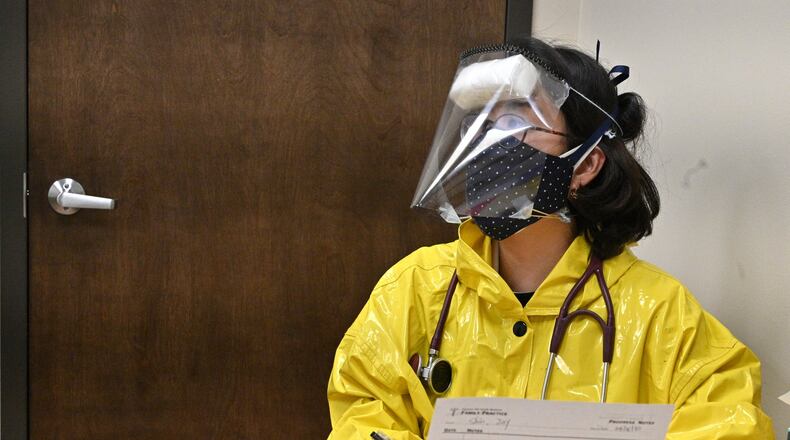Years of seasonal flu data in Georgia tell a clear story: the state’s most rural residents, who tend to be poorer, older, less educated and farther from health care, die at higher rates than those living in urban centers such as metro Atlanta.
Experts are unsure if the same will hold true for COVID-19.
Many of the risk factors that put rural Georgians at greater risk for flu also hold true for COVID-19, which is more deadly for older people and those with underlying health problems. But COVID-19 flourishes in densely populated areas. Those in rural areas may benefit from their isolation.
» COMPLETE COVERAGE: Coronavirus in Georgia
“I’d put the emphasis on population density,” said William Schaffner, a professor of preventive medicine at Vanderbilt University and an expert in infectious diseases. In the short term, Schaffner said he believes COVID-19 is more dangerous for those in urban areas.
“Over time, (the virus) would ease on out to the rural areas,” he said. “It might take a little time to spread out there.”
The state’s history with the flu is important. The Georgia Department of Public Health has a detailed response plan for a massive flu pandemic, the details of which mirror much of the response to COVID-19. For instance, the plan contemplates social distancing measures, including travel restrictions and the closing of schools, and prepares for shortages of medical equipment like ventilators.
Documents obtained by the AJC show the Georgia Emergency Management Agency requested the plan on March 3, just as concerns about COVID-19 heated up.
Rural death rates from flu
The AJC analyzed 10 years of influenza and pneumonia data from the Centers for Disease Control and Prevention and found rural counties had a death rate more than two and half times that of the state’s large metro counties.
Over the past 10 years, at least 14,578 Georgians have died from flu or pneumonia. Most of those deaths occurred Georgia’s urban centers, which is also where most of the population lives. But the CDC data shows patients in rural parts of the state were much more likely to perish from the virus than patients in cities.
For example, the state’s 29 largest metro counties, which are home to more than half of the state’s 10.5 million residents, lost about 6,000 people to flu and pneumonia over the past decade.
Comparatively, the 57 most rural counties had just under 2,000 deaths over the same period. But those sparsely populated counties together have fewer than 1 million residents, meaning the death rate in those counties was two and a half times greater than in large metro counties.
» RELATED: Flu season shaping up to be one of the worst in years
» MORE: Stay or go: Kids with flu pose parental puzzle
The people in rural counties tend to be older, poorer and in generally worse health than their city counterparts, Schaffner said. They also have worse access to doctors and hospitals than residents of urban centers, which puts them at far greater risk when they get seriously ill, he said.
One such place is Miller County in far southwest Georgia. Miller County had an age-adjusted death rate four times greater than the state’s large urban counties. The county of 5,686 recorded 35 flu-related deaths over the past decade, according to the CDC data.
Bill Swofford, a family practice physician in the county seat of Colquitt, said influenza waxes and wanes from year to year in his community. The worst he can recall was in 2009 during the H1N1 global flu pandemic.
“I just remember people were sick. The vaccine that year didn’t work like it should,” he said. “I lost several elderly patients.”
» RELATED: Coronavirus exacts heavy toll in southwest Georgia
Swofford said he thinks a range of community factors, including access to care and the population's general health, play a role in his county's deaths.
"We have a lot of poor people (with) a lot of underlying health conditions," he said.
Poverty is another factor, he said. “I see a lot of people, we give them medicine and we find out they didn’t get it because they couldn’t afford it,” he said.
The CDC data analyzed by the AJC lists such risk factors for each county in a measurement called the Social Vulnerability Index. Georgia's large metro counties are in the 45th percentile among all U.S. counties, while small cities in rural areas are in the 82nd percentile because of high rates of poverty, advanced age, minority status and other factors. Higher percentiles translate to higher vulnerability.
Virus will tax all areas
But flu and COVID-19 are not same. There are natural and acquired immunities that protect people from the flu, most importantly the annual flu vaccines. And many older Americans and those with compromised immunity get a separate vaccine for pneumonia. There is no such protection from the coronavirus.
“COVID-19 is a novel pandemic pathogen, meaning before this pandemic, nobody had any existing immunity,” said Maria Sundaram, an infectious disease epidemiologist and postdoctoral fellow at Emory University’s Rollins School of Public Health.
"We have a lot of poor people (with) a lot of underlying health conditions. I see a lot of people, we give them medicine and we find out they didn't get it because they couldn't afford it." —Bill Swofford, a family practice physician in Colquitt
“A lot of people are likely to get sick in a short period of time, which is very dangerous for health care infrastructure,” she said.
As people get sick, the strain is more keenly felt in areas where poor health-care access is endemic.
“Lack of access to health care in rural areas doesn’t just mean it’s hard to get to the hospital when you have a severe COVID-19 infection,” she said. “It could also mean it’s harder to have well-controlled diabetes, or harder to get a diagnosis of congestive heart failure, etc. We know these underlying conditions also contribute to increased risk for severe COVID-19 disease.”
The deadliest spot in Georgia for COVID-19 is Dougherty County in southwest Georgia where 44 people have died of the virus. Dougherty’s largest city is Albany and is classified in the AJC analysis as a “small metro” county. The CDC puts the county in the 95th percentile in its social vulnerability ranking due to high poverty and unemployment and large minority population, all of which impact overall health.
Schaffner, the Vanderbilt disease expert, said the greatest problem facing the country isn’t access to care, but a lack of good options to stop the spread. With the flu, there is a vaccine and antiviral medications, like Tamiflu. With COVID-19, isolation is the best defense.
“It’s the only bullet in our gun,” he said.
Sundaram said it is too early to predict whether rural or urban areas will fare better in the current outbreak.
“In both urban and rural areas, I believe that existing health-care inequities — racial, socioeconomic, and others — are likely to be made more apparent by this outbreak,” she said.
Keep Reading
The Latest
Featured





